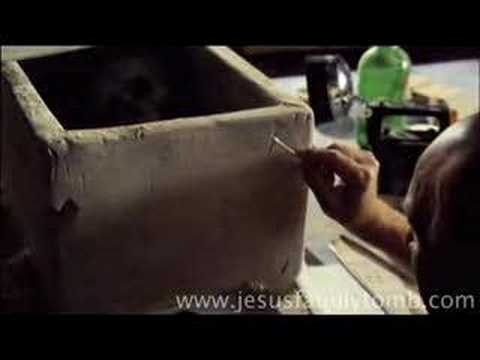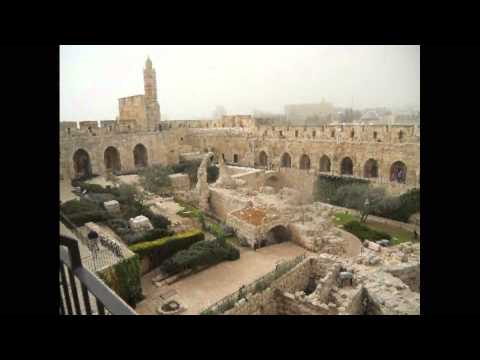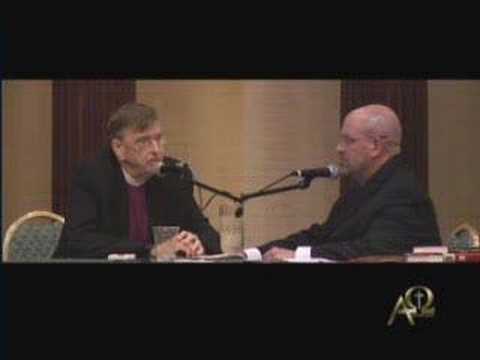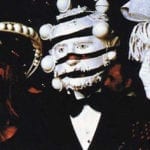10 Mummy Masks
Are we reading the correct version of the Bible? Do we have the right to find out if we are? Those are two of the controversies surrounding the destruction of papyrus mummy masks to find scraps of the Bible and other ancient documents. If you watch the video above (starting at 24:22 minutes), you’ll see Christian apologist Josh McDowell demonstrate the process we’re about to discuss. Until recently, the earliest known copies of the gospels were from the second century AD. But we may be able to retrieve earlier fragments of biblical text from used sheets of papyrus that were fashioned into mummy masks with paint and glue for ordinary people in ancient times. Papyrus was so expensive back then that people used discarded sheets with writing—old business agreements, personal letters, and the occasional fragment of gospel text. By looking at dates on some of the retrieved documents, scientists can approximate the age of the undated documents. They also use carbon-14 dating and handwriting analysis. In this case, the controversy surrounds a piece of the Gospel of Mark that supposedly dates to the first century, potentially the earliest known copy. This would show us what changes scribes made to the gospel over time. Although each mask may yield as many as 25 texts, the masks are destroyed in the process, which some people feel is an unacceptable trade-off. However, Craig Evans, a professor of New Testament studies, defended the process in an interview with LiveScience. “We’re not talking about the destruction of any museum-quality piece,” he said. Actually, no one’s talking much at all. The owners of these masks—whether private collectors, universities, or museums—have insisted that those involved sign nondisclosure agreements to keep them quiet. Someone leaked the information about the Gospel of Mark in 2012. There’s also controversy over how the papyrus is extracted from these masks. If you watch the video above, McDowell seems almost giddy about soaking the masks in a mixture of Palmolive dishwashing liquid and water to dissolve the paint and glue, wringing them out with his unwashed hands, and using a tweezers to pull apart the papyrus sheets. He doesn’t care if these valuable papyri rip because the masks are privately owned. He also refers to these documents as a “career maker,” which some may consider to be an inappropriate way to approach the Word of God.
9 The Law$uit Over Biblical Archaeology
We’ve already talked about the controversial television special The Lost Tomb of Jesus, which was directed by Canadian filmmaker Simcha Jacobovici, executive-produced by James Cameron, and broadcast on the Discovery Channel and Vision TV in 2007. The special suggested that there was a tomb in Israel that contained the remains of the biblical Jesus and His family, possibly including a son named Judah. Obviously, those claims set off an intense religious debate, including accusations of profiteering against Jacobovici and Cameron. Many people believe that Jesus was resurrected, so it would be impossible to find His bones. Many also believe He never married or had children. But even negative publicity can juice viewership and profits, so it’s not always unwelcome for filmmakers who tackle controversial subjects. In this case, Jacobovici eventually sued archaeologist Joseph Zias, a retired Israel Antiquities Authority official, for $1 million in damages for libel. As part of his barrage of critical blog posts and emails, Zias had a habit of spelling Jacobovici’s first name with a dollar sign instead of an S. But what may have pushed Jacobovici over the edge was National Geographic dropping another of his projects, literally changing at least one way we might view the Bible. Jacobovici claimed he lost over $2 million in revenue as a result of Zias’s actions. Many biblical scholars took sides, some agreeing that Zias went too far, others claiming that the two men should debate each other, not stifle free speech by facing off in court. In 2015, a Jerusalem court awarded $260,000 in damages to Jacobovici. After the decision, the filmmaker wrote on his website: As a journalist, I’m committed to the principle of free debate in a democratic society. But free speech ends where libel begins, and Zias crossed every red line of a civilized debate. He accused me, among other things, of “forgery”, “planting archaeology”, “pimping the Bible” and “inventing Holocaust stories”. He also accused me of being in intimate contact with various criminal elements around the world. All these are horrible, made up lies that he circulated on the Internet and sent to various universities, publishers and broadcasters.
8 The Ophel Inscription
An ongoing debate among biblical scholars is whether the Old Testament was written in real time or centuries after the events were supposed to have happened. Until 2008, it was usually believed that the Hebrew Bible was written in the sixth century BC because there was no evidence of Hebrew writing before that time. Then a pottery shard from the 10th century BC inscribed with Hebrew writing was discovered at Khirbet Qeiyafa in Israel. “It indicates that the Kingdom of Israel already existed in the 10th century BCE and that at least some of the biblical texts were written hundreds of years before the dates presented in current research,” said Professor Gershon Galil, who deciphered the ancient text, to LiveScience. Routinely, the two major camps in biblical archaeology duke it out as to whether each new find proves that the Bible is a historical document or not. Even so, this pottery shard wasn’t enough to confirm that the Old Testament was written in real time. Then in 2013, the “Ophel Inscription” was found on a fragment of a clay jug near the Temple Mount (in the Ophel area) in Jerusalem. Touching off another dispute between the two camps, they couldn’t even agree on the language of the inscription, let alone what it said. But the fragment did appear to date to the 10th century BC. Although some scholars believed the writing was from a Near Eastern language other than Hebrew, Galil interpreted the writing as ancient Hebrew that classified wine stored in the container. He believes it refers to cheap wine given to slave laborers. However, the cheap wine is not important. If Galil is correct, the Ophel Inscription suggests that Jerusalem was already an important city in the 10th century BC, with a class structure and a complex administrative system. Also, it suggests that writing was widespread at that time. “Scribes that could write administrative texts could also write literary and historiographic texts,” Galil told The Times of Israel. Although it’s controversial, some scholars believe that if Jerusalem was populated by Hebrew speakers and writers in the 10th century BC, then scribes were probably recording the events of the Old Testament in real time, which would make the Bible more of a historically accurate book. A few more inscriptions from the 10th century BC have been found since then.
7 God’s Wife
Based on certain archaeological finds and references in the Hebrew Bible, some archaeologists and biblical scholars believe that God had a wife, Asherah, and that ancient Israelites worshiped both of them. Historian Raphael Patai first proposed this theory in 1967. Then in 2012, researcher Francesca Stavrakopoulou reintroduced the idea, citing evidence from ancient artifacts and texts. According to Stavrakopoulou, Asherah’s statue was worshiped in Jerusalem in Yahweh’s temple. The Book of Kings talks about women at the temple weaving ritual garments for Asherah. “Asherah was not entirely edited out of the Bible by its male editors,” J. Edward Wright, president of The Arizona Center for Judaic Studies, told Discovery News. “Traces of her remain, and based on those traces, archaeological evidence and references to her in texts from nations bordering Israel and Judah, we can reconstruct her role in the religions of the Southern Levant.” Wright adds that Asherah’s name has often been translated as “Sacred Tree” in English-language Bibles. This was done to concentrate worship on Yahweh only. However, the biblical references weren’t enough to establish that Asherah was Yahweh’s wife. Figurines, amulets, and other ancient texts helped. At Kuntillet Ajrud in the Sinai Desert, archaeologists discovered pottery with an eighth-century inscription requesting a blessing from “Yahweh and his Asherah.” More inscriptions like that have been uncovered, which Stavrakopoulou and others believe is strong evidence that Asherah was Yahweh’s wife. Most biblical scholars concede that the ancient Israelites of the Old Testament worshiped many gods, but they still think that characterizing Asherah as God’s wife is too much of a leap of logic. “We have to be cautious about trying to draw too much information about something like ‘religion’ from material culture,” Michael Press, an expert in Philistine culture and religion, told Haaretz. “Archaeologists have a very difficult job in reconstructing the world of ideas, how people thought, from material remains. There is a gigantic interpretive leap from concrete remains to abstract theory. And at best we only get glimpses of that sort of world of ideas and imagination.” Other critics aren’t so diplomatic. Andy Rau on the BibleGateway Blog says there’s no evidence in the Bible that God had a wife. To claim otherwise, he believes, is to offer a conspiracy theory where much of the Bible was falsified after the fact.
6 The Location Of The Trial Of Jesus
Although it’s one of the more important scenes in the Bible, archaeologists can’t agree on where the trial of Jesus took place. During an expansion of the Tower of David Museum in Jerusalem near the turn of the 21st century, archaeologists believed they had discovered the sewage system and foundation walls of the ancient palace of Herod the Great. Many believe the trial of Jesus was held there before He was crucified. At that time, Herod was the King of Judea appointed by Rome. The supposed remains of his palace were found under an abandoned prison next to the modern museum. The New Testament gospels appear to give conflicting accounts of the location of Jesus’s trial. In the Gospel of John, the trial is said to have occurred on a stone pavement close to a gate. That matches with Herod’s palace. But the gospels also use the Latin word “praetorium” to describe where Pontius Pilate examined Jesus. While some scholars believe that Pilate would have stayed in Herod’s palace, others say that a praetorium was a general’s tent in a Roman military camp. Even though the debate isn’t settled, the prison is open to the public for tours. “There is, of course, no inscription stating [the trial] happened [at the prison site where Herod’s palace was unearthed], but everything—archaeological, historical and gospel accounts—all falls into place and makes sense,” archaeology professor Shimon Gibson told The Washington Post.
5 The Hushed-Up Pillar
In 2013, Israeli tour guide Binyamin Tropper happened upon an important historical artifact, a rare carved stone known as a “proto-aeolic capital” that was still attached to its base. This pillar appeared to be a monument at the entrance of a major archaeological site from the ninth or eighth century BC at Ein Joweizeh in the rural West Bank, close to Jerusalem. The site may be associated with a biblical Jewish king from that era and possibly provide evidence that certain stories in the Old Testament are true. Eager to see the site excavated, Tropper told his boss, Yaron Rosenthal, about it. Rosenthal then notified the Israel Antiquities Authority (IAA). According to The Jewish Press, he got a surprising reply from an unnamed IAA official: “Yaron, please, you found it, but we know about it. Now forget the whole thing and keep your mouth shut.” Rosenthal learned that the IAA had known about the pillar for 18 months. He was unhappy that the site was neither being excavated nor protected from damage. Even more concerning, it was on the Palestinian side of a security fence dividing South Jerusalem from the Palestinian Authority’s Bethlehem County. Rather than abide by the IAA’s wishes, Tropper decided to announce the find in the Hebrew press. The pillar identifies the entrance to a 160-meter (525 ft) spring tunnel system, which may have been used to provide water for a palace or large farm from biblical times. But the politics of the situation makes an excavation difficult. The Jews see their significant archaeological discoveries as a way to prove their historical connection to the land. But the Palestinians prefer to deny ancient Jewish history in order to weaken modern Jewish control of the area. So the Palestinians would probably be reluctant to see a dig on land that they want to control. Currently, the land is privately owned by a Palestinian.
4 New Testament Forgeries And Lies
Forged, a book by biblical scholar Bart Ehrman, was published in 2011 to a storm of controversy. Ehrman charged that about half of the New Testament was forged by people who had a religious agenda in the ancient world but couldn’t make it work under their own names. “There was competition among different groups of Christians about what to believe and each of these groups wanted to have authority to back up their views,” he said in an interview with CNN. “If you were a nobody, you wouldn’t sign your own name to your treatise. You would sign Peter or John.” Ehrman says that forgers lied for what they believed was the greater good. It was also a way for ancient Christian leaders to win their religious feuds with each other. In his book, Ehrman gives examples of Paul’s writing in the New Testament that vary in style: short sentences in some parts, longer sentences that don’t appear to be his style in others. Some of the passages even contradict each other. Finally, Ehrman claims that the apostles Peter and John were illiterate fishermen, so they couldn’t have written any of the New Testament. It didn’t take long for other biblical scholars to tear Ehrman’s conclusions apart. One of them, Ben Witherington, refers to Ehrman’s book as “Gullible Travels,” complaining that people will believe anything, no matter how outrageous. Witherington says that, except for 2 Peter, every book in the New Testament was written by a member of a small group of educated Christians, each of whom could write well and some of whom had witnessed the events described in the New Testament. They had close connections to Jesus and Paul. According to Witherington, scribes were essential to correctly transcribing documents and making the prose more eloquent in ancient times. It was common for people like Paul to dictate their words to a scribe. However, Witherington admitted that forgeries were common at that time. Nevertheless, he doesn’t agree that Peter and John had to be illiterate just because they were fishermen. Witherington believes that fishermen had to write and sign contracts as part of their work. Ehrman insists that he’s not trying to harm the Bible’s reputation. He just wants people to understand that the New Testament isn’t the Word of God. For him, it’s a human document written by people who lied about their identities.
3 The Bible’s View Of Homosexuality
In 2012, an anonymous group published the Queen James Bible (QJB), editing eight verses of the popular King James Version (KJV) in an attempt to make it impossible to interpret the Bible in a homophobic way. Steve Golden from Answers in Genesis believes the editors of the QJB “have only made a mockery of a beloved Bible translation.” For example, in Leviticus 18:22, the QJB adds five words (shown here in italics) to the KJV: “Thou shalt not lie with mankind as with womankind in the temple of Molech: it is an abomination.” This rewritten passage now condemns having sex with male prostitutes in particular temples, a type of pagan idolatry, rather than denouncing certain sex acts. In general, Golden argues that pro-gay advocates have misinterpreted the Hebrew word for “ritually unclean” as relating to pagan idolatry only when it is used to condemn “something that is morally (ethically) repugnant in God’s sight, such as homosexuality ([as in] Proverbs 6:16).” Golden also mentions two other chapters in Leviticus that specify sinful behavior, such as bestiality, child sacrifice, and incest. He then argues that the editors of the QJV must be consistent in applying their changes to these chapters as well, which would make bestiality, child sacrifice, and incest acceptable unless pagan idolatry were involved. So his conclusion is that homosexuality must be a sin whether or not it involves pagan idolatry. Golden takes aim at other biblical scholars with Romans 1:26–27, which talks about men and women who “exchanged natural relations for unnatural ones.” Here, he argues that the apostle Paul condemned both homosexuals and those who approve of them. However, John Shelby Spong, a retired bishop of the Episcopal Church, says in an interview posted on YouTube (shown in the video above) that he believes Paul was a repressed homosexual, whose self-loathing explains why he so forcefully opposed homosexuality. In another view, David Field, former Vice-Principal of Oak Hill Theological College, believes those verses are aimed at heterosexuals who engage in homosexual intercourse that is unnatural for them. With many people now believing that we can’t choose our sexual orientation, Field says that homosexuals would not be condemned under those verses because “same-sex intercourse [is] the most natural thing in the world for them.”
2 Exodus And Abortion
In the religious debate over abortion, people often argue over the meaning of Exodus 21:22–25. In the Douay-Rheims version of the Bible, it says: “If men quarrel, and one strike a woman with child, and she miscarry indeed, but live herself: he shall be answerable for so much damage as the woman’s husband shall require, and as arbiters shall award. But if her death ensue thereupon, he shall render life for life. Eye for eye, tooth for tooth, hand for hand, foot for foot, burning for burning, wound for wound, stripe for stripe.” Pro-choice advocates interpret “miscarry” to mean that the unborn child doesn’t have the same life status as the adult woman. If the baby dies as a result of a miscarriage, then the man responsible is only fined, as with a misdemeanor. But if the woman dies as a result of being hit, then the man has committed a capital offense punishable by death. Pro-life advocates often disagree with the use of the word “miscarry” in this version of the Bible. Even so, they argue that the baby’s death was accidental, unlike abortion which is the intentional taking of a life. They also claim that even an accidental death in this case is evil or the man wouldn’t be fined. Furthermore, the death penalty isn’t meted out for accidental death in the Bible as shown in Exodus 21:13–14 and 20–21, Numbers 35:10–34, and Deuteronomy 19:1–13. John Piper, chancellor of Bethlehem College & Seminary, points out that the New International Version of the Bible translates that passage as “she gives birth prematurely” instead of “she miscarry indeed,” which suggests that the baby was born alive. In this case, the man pays a fine if the mother or child is injured, but he’s put to death if the mother or child dies. Piper says there’s a Hebrew word for “miscarry” which wasn’t used in this passage. Rabbi Shmuley Boteach agrees with the pro-choice advocates. He says that, according to the Jewish interpretation of that Exodus passage, the fetus does not have the same status of life as the adult woman. Therefore, he believes that taking the life of an unborn child is not murder. He acknowledges that the Jewish interpretation of Exodus is different than the Catholic one.
1 Joshua’s Conquest Of Jericho
An oasis in the desert of the West Bank, Jericho is believed to be the earliest city in the world that was continuously inhabited. At various times, at least 23 civilizations have made Jericho their home. As told in the Book of Joshua in the Bible, Joshua led the Israelites to Jericho, the heart of the Promised Land. But when he arrived, he had to conquer the Canaanites with his army in a bloody battle reminiscent of the goriest Hollywood action movie. According to the Bible, on the seventh day, Joshua circled the outside walls of the city seven times with the powerful Ark of the Covenant, the chest which contained the stone tablets inscribed with the Ten Commandments. Then God caused the walls of the city to crumble, and Joshua and his men stormed in, killing everyone except Rahab and her family. Rahab was the prostitute who had helped Joshua’s spies. So far, archaeological digs don’t support the biblical story of Joshua attacking Jericho. It appears that no one was living in Jericho at the time of Joshua, and no walls existed, either. (Some researchers believe there is evidence for Joshua’s conquest, just at a different time in history.) However, it seems more likely that the Israelites slipped into the sparsely inhabited hill country more gradually as described in the Book of Judges. For some believers, that’s a relief. They can’t reconcile their loving, merciful God with the God who condoned such widespread slaughter. It does open another interesting question, though. What if the ancient Israelites and the Canaanites of the Bible were once part of the same tribe, which appears to be supported by DNA analysis? According to biblical archaeologist Eric Cline, modern DNA testing may show that today’s Jews and Palestinians, who are locked in a violent conflict of their own, are distant brothers or cousins from that tribe. The inability to confirm the biblical story of Joshua’s conquest of Jericho may have far greater implications than whether the Bible is an accurate historical document.























